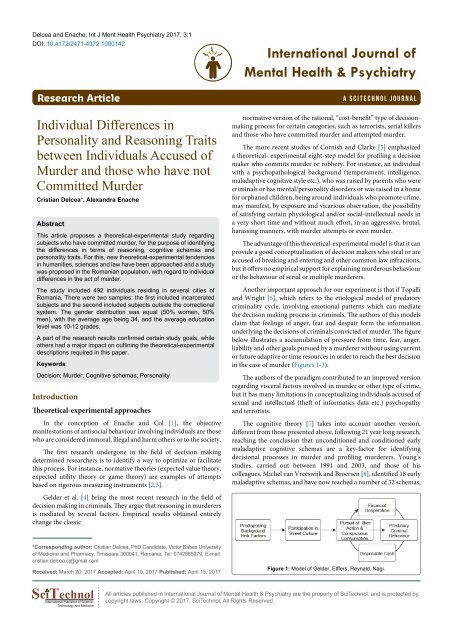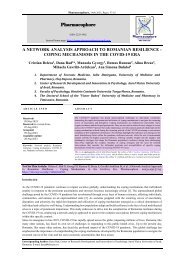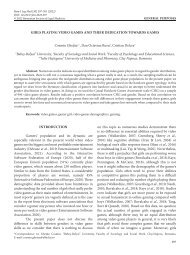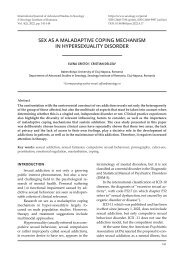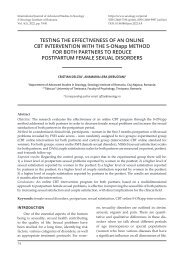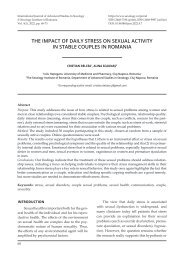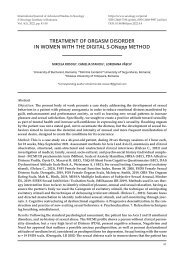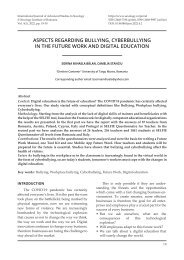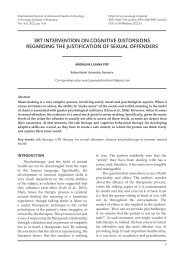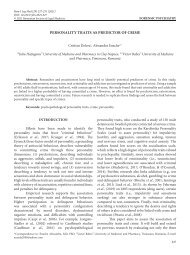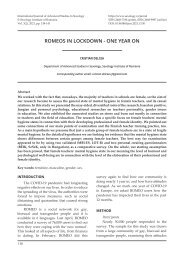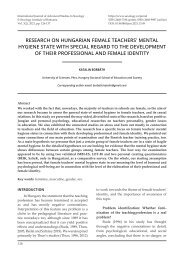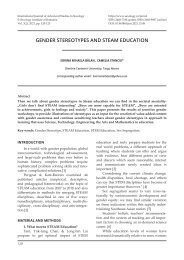Individual Differences in Personality and Reasoning Traits between Individuals Accused of Murder and those who have not Committed Murder
This article proposes a theoretical-experimental study regarding subjects who have committed murder, for the purpose of identifying the differences in terms of reasoning, cognitive schemas and personality traits. For this, new theoretical-experimental tendencies in humanities, sciences and law have been approached and a study was proposed in the Romanian population, with regard to individual differences in the act of murder. The study included 492 individuals residing in several cities of Romania. There were two samples: the first included incarcerated subjects and the second included subjects outside the correctional system. The gender distribution was equal (50% women, 50% men), with the average age being 34, and the average education level was 10-12 grades. A part of the research results confirmed certain study goals, while others had a major impact on outlining the theoretical-experimental descriptions required in this paper.
This article proposes a theoretical-experimental study regarding
subjects who have committed murder, for the purpose of identifying
the differences in terms of reasoning, cognitive schemas and
personality traits. For this, new theoretical-experimental tendencies
in humanities, sciences and law have been approached and a study
was proposed in the Romanian population, with regard to individual
differences in the act of murder.
The study included 492 individuals residing in several cities of
Romania. There were two samples: the first included incarcerated
subjects and the second included subjects outside the correctional
system. The gender distribution was equal (50% women, 50%
men), with the average age being 34, and the average education
level was 10-12 grades.
A part of the research results confirmed certain study goals, while
others had a major impact on outlining the theoretical-experimental
descriptions required in this paper.
Create successful ePaper yourself
Turn your PDF publications into a flip-book with our unique Google optimized e-Paper software.
Delcea <strong>and</strong> Enache, Int J Ment Health Psychiatry 2017, 3:1<br />
DOI: 10.4172/2471-4372.1000142<br />
International Journal <strong>of</strong><br />
Mental Health & Psychiatry<br />
Research Article<br />
<strong>Individual</strong> <strong>Differences</strong> <strong>in</strong><br />
<strong>Personality</strong> <strong>and</strong> Reason<strong>in</strong>g <strong>Traits</strong><br />
<strong>between</strong> <strong>Individual</strong>s <strong>Accused</strong> <strong>of</strong><br />
<strong>Murder</strong> <strong>and</strong> <strong>those</strong> <strong>who</strong> <strong>have</strong> <strong>not</strong><br />
<strong>Committed</strong> <strong>Murder</strong><br />
Cristian Delcea*, Alex<strong>and</strong>ra Enache<br />
Abstract<br />
This article proposes a theoretical-experimental study regard<strong>in</strong>g<br />
subjects <strong>who</strong> <strong>have</strong> committed murder, for the purpose <strong>of</strong> identify<strong>in</strong>g<br />
the differences <strong>in</strong> terms <strong>of</strong> reason<strong>in</strong>g, cognitive schemas <strong>and</strong><br />
personality traits. For this, new theoretical-experimental tendencies<br />
<strong>in</strong> humanities, sciences <strong>and</strong> law <strong>have</strong> been approached <strong>and</strong> a study<br />
was proposed <strong>in</strong> the Romanian population, with regard to <strong>in</strong>dividual<br />
differences <strong>in</strong> the act <strong>of</strong> murder.<br />
The study <strong>in</strong>cluded 492 <strong>in</strong>dividuals resid<strong>in</strong>g <strong>in</strong> several cities <strong>of</strong><br />
Romania. There were two samples: the first <strong>in</strong>cluded <strong>in</strong>carcerated<br />
subjects <strong>and</strong> the second <strong>in</strong>cluded subjects outside the correctional<br />
system. The gender distribution was equal (50% women, 50%<br />
men), with the average age be<strong>in</strong>g 34, <strong>and</strong> the average education<br />
level was 10-12 grades.<br />
A part <strong>of</strong> the research results confirmed certa<strong>in</strong> study goals, while<br />
others had a major impact on outl<strong>in</strong><strong>in</strong>g the theoretical-experimental<br />
descriptions required <strong>in</strong> this paper.<br />
Keywords<br />
Decision; <strong>Murder</strong>; Cognitive schemas; <strong>Personality</strong><br />
Introduction<br />
Theoretical-experimental approaches<br />
In the conception <strong>of</strong> Enache <strong>and</strong> Col [1], the objective<br />
manifestations <strong>of</strong> antisocial behaviour <strong>in</strong>volv<strong>in</strong>g <strong>in</strong>dividuals are <strong>those</strong><br />
<strong>who</strong> are considered immoral, illegal <strong>and</strong> harm others or to the society.<br />
The first research undergone <strong>in</strong> the field <strong>of</strong> decision mak<strong>in</strong>g<br />
determ<strong>in</strong>ed researchers is to identify a way to optimize or facilitate<br />
this process. For <strong>in</strong>stance, normative theories (expected value theory,<br />
expected utility theory or game theory) are examples <strong>of</strong> attempts<br />
based on rigorous measur<strong>in</strong>g <strong>in</strong>struments [2,3].<br />
a SciTechnol journal<br />
normative version <strong>of</strong> the rational, “cost-benefit” type <strong>of</strong> decisionmak<strong>in</strong>g<br />
process for certa<strong>in</strong> categories, such as terrorists, serial killers<br />
<strong>and</strong> <strong>those</strong> <strong>who</strong> <strong>have</strong> committed murder <strong>and</strong> attempted murder.<br />
The more recent studies <strong>of</strong> Cornish <strong>and</strong> Clarke [5] emphasized<br />
a theoretical- experimental eight-step model for pr<strong>of</strong>il<strong>in</strong>g a decision<br />
maker <strong>who</strong> commits murder or robbery. For <strong>in</strong>stance, an <strong>in</strong>dividual<br />
with a psychopathological background (temperament, <strong>in</strong>telligence,<br />
maladaptive cognitive style etc.), <strong>who</strong> was raised by parents <strong>who</strong> were<br />
crim<strong>in</strong>als or has mental/personality disorders or was raised <strong>in</strong> a home<br />
for orphaned children, be<strong>in</strong>g around <strong>in</strong>dividuals <strong>who</strong> promote crime,<br />
may manifest, by exposure <strong>and</strong> vicarious observation, the possibility<br />
<strong>of</strong> satisfy<strong>in</strong>g certa<strong>in</strong> physiological <strong>and</strong>/or social-<strong>in</strong>tellectual needs <strong>in</strong><br />
a very short time <strong>and</strong> without much effort, <strong>in</strong> an aggressive, brutal,<br />
harass<strong>in</strong>g manners, with murder attempts or even murder.<br />
The advantage <strong>of</strong> this theoretical-experimental model is that it can<br />
provide a good conceptualization <strong>of</strong> decision makers <strong>who</strong> steal or are<br />
accused <strong>of</strong> break<strong>in</strong>g <strong>and</strong> enter<strong>in</strong>g <strong>and</strong> other common law <strong>in</strong>fractions,<br />
but it <strong>of</strong>fers no empirical support for expla<strong>in</strong><strong>in</strong>g murderous behaviour<br />
or the behaviour <strong>of</strong> serial or multiple murderers.<br />
A<strong>not</strong>her important approach for our experiment is that if Topalli<br />
<strong>and</strong> Wright [6], which refers to the etiological model <strong>of</strong> predatory<br />
crim<strong>in</strong>ality cycle, <strong>in</strong>volv<strong>in</strong>g emotional patterns which can mediate<br />
the decision mak<strong>in</strong>g process <strong>in</strong> crim<strong>in</strong>als. The authors <strong>of</strong> this models<br />
claim that feel<strong>in</strong>gs <strong>of</strong> anger, fear <strong>and</strong> despair form the <strong>in</strong>formation<br />
underly<strong>in</strong>g the decisions <strong>of</strong> crim<strong>in</strong>als convicted <strong>of</strong> murder. The figure<br />
below illustrates a accumulation <strong>of</strong> pressure from time, fear, anger,<br />
liability <strong>and</strong> other goals pursued by a murderer without us<strong>in</strong>g current<br />
or future adaptive or time resources <strong>in</strong> order to reach the best decision<br />
<strong>in</strong> the case <strong>of</strong> murder (Figures 1-3).<br />
The authors <strong>of</strong> the paradigm contributed to an improved version<br />
regard<strong>in</strong>g visceral factors <strong>in</strong>volved <strong>in</strong> murder or other type <strong>of</strong> crime,<br />
but it has many limitations <strong>in</strong> conceptualiz<strong>in</strong>g <strong>in</strong>dividuals accused <strong>of</strong><br />
sexual <strong>and</strong> <strong>in</strong>tellectual (theft <strong>of</strong> <strong>in</strong>formatics data etc.) psychopathy<br />
<strong>and</strong> terrorists.<br />
The cognitive theory [7] takes <strong>in</strong>to account a<strong>not</strong>her version,<br />
different from <strong>those</strong> presented above, follow<strong>in</strong>g 21 year long research,<br />
reach<strong>in</strong>g the conclusion that unconditioned <strong>and</strong> conditioned early<br />
maladaptive cognitive schemas are a key-factor for identify<strong>in</strong>g<br />
decisional processes <strong>in</strong> murder <strong>and</strong> pr<strong>of</strong>il<strong>in</strong>g murderers. Young’s<br />
studies, carried out <strong>between</strong> 1991 <strong>and</strong> 2003, <strong>and</strong> <strong>those</strong> <strong>of</strong> his<br />
colleagues, Michel van Vreeswijk <strong>and</strong> Broersen [8], identified 18 early<br />
maladaptive schemas, <strong>and</strong> <strong>have</strong> now reached a number <strong>of</strong> 32 schemas,<br />
Gelder et al. [4] br<strong>in</strong>g the most recent research <strong>in</strong> the field <strong>of</strong><br />
decision mak<strong>in</strong>g <strong>in</strong> crim<strong>in</strong>als. They argue that reason<strong>in</strong>g <strong>in</strong> murderers<br />
is mediated by several factors. Empirical results obta<strong>in</strong>ed entirely<br />
change the classic<br />
*Correspond<strong>in</strong>g author: Cristian Delcea, PhD C<strong>and</strong>idate, Victor Babes University<br />
<strong>of</strong> Medic<strong>in</strong>e <strong>and</strong> Pharmacy, Timisoara 300041, Romania, Tel: 0742885979; E-mail:<br />
cristian.delcea.cj@gmail.com<br />
Received: March 20, 2017 Accepted: April 10, 2017 Published: April 15, 2017<br />
Figure 1: Model <strong>of</strong> Gelder, Elffers, Reynald, Nagi.<br />
International Publisher <strong>of</strong> Science,<br />
Technology <strong>and</strong> Medic<strong>in</strong>e<br />
All articles published <strong>in</strong> International Journal <strong>of</strong> Mental Health & Psychiatry are the property <strong>of</strong> SciTechnol, <strong>and</strong> is protected by<br />
copyright laws. Copyright © 2017, SciTechnol, All Rights Reserved.
Citation: Delcea C, Enache A (2017) <strong>Individual</strong> <strong>Differences</strong> <strong>in</strong> <strong>Personality</strong> <strong>and</strong> Reason<strong>in</strong>g <strong>Traits</strong> <strong>between</strong> <strong>Individual</strong>s <strong>Accused</strong> <strong>of</strong> <strong>Murder</strong> <strong>and</strong> <strong>those</strong> <strong>who</strong> <strong>have</strong> <strong>not</strong><br />
<strong>Committed</strong> <strong>Murder</strong>. Int J Ment Health Psychiatry 3:1.<br />
doi: 10.4172/2471-4372.1000142<br />
Attack, the crim<strong>in</strong>al uses threats or aggression to <strong>in</strong>timidate others;<br />
the Paranoid Over mode describes a search <strong>and</strong> control behaviour,<br />
with psychopathological hyper-vigilance <strong>and</strong> suspect<strong>in</strong>g <strong>in</strong>dividuals<br />
<strong>of</strong> hav<strong>in</strong>g hidden purposes <strong>and</strong> wish<strong>in</strong>g to hurt or humiliate them.<br />
In the Conn<strong>in</strong>g <strong>and</strong> Manipulative manifestation mode, the crim<strong>in</strong>al<br />
presents a “fake self” by ly<strong>in</strong>g, cheat<strong>in</strong>g or other manipulation<br />
methods, <strong>in</strong> order to atta<strong>in</strong> a certa<strong>in</strong> crim<strong>in</strong>al purpose. The last mode<br />
illustrates the lack <strong>of</strong> empathy, distanc<strong>in</strong>g <strong>and</strong> merciless attitudes<br />
used for punish<strong>in</strong>g victims. This paradigm has the highest empirical<br />
validity <strong>and</strong> good predictability <strong>in</strong> pr<strong>of</strong>il<strong>in</strong>g <strong>and</strong> outl<strong>in</strong><strong>in</strong>g a decision<br />
maker <strong>who</strong> commits murder. In relation to the strength <strong>of</strong> the studies<br />
<strong>and</strong> assessment/test<strong>in</strong>g <strong>in</strong>struments, with discrim<strong>in</strong>atory power<br />
<strong>between</strong> cl<strong>in</strong>ical <strong>and</strong> non-cl<strong>in</strong>ical sample, our studies took <strong>in</strong>to<br />
account this paradigm <strong>and</strong> the <strong>in</strong>struments which <strong>have</strong> been adapted<br />
<strong>and</strong> scientifically validated on the Romanian population, <strong>in</strong> order to<br />
identify <strong>in</strong>dividual differences <strong>in</strong> the act <strong>of</strong> murder.<br />
Research objectives<br />
Figure 2: <strong>Differences</strong> <strong>in</strong> personality traits <strong>between</strong> subjects <strong>who</strong> <strong>have</strong><br />
committed murder <strong>and</strong> subjects <strong>who</strong> <strong>have</strong> <strong>not</strong> (1- NP, 2 P).<br />
The research proposed has the goal <strong>of</strong> def<strong>in</strong><strong>in</strong>g <strong>in</strong>dividual<br />
differences <strong>in</strong> the act <strong>of</strong> murder, for a better pr<strong>of</strong>il<strong>in</strong>g <strong>and</strong> prediction<br />
<strong>of</strong> <strong>those</strong> <strong>who</strong> decide to kill. The general <strong>and</strong> specific objectives below<br />
are all conta<strong>in</strong>ed <strong>in</strong> this study.<br />
General objective: Subjects <strong>who</strong> <strong>have</strong> been imprisoned for<br />
murder <strong>have</strong> personality traits which are different compared to <strong>those</strong><br />
<strong>of</strong> <strong>in</strong>dividuals <strong>who</strong> <strong>have</strong> <strong>not</strong> murdered.<br />
Specific objectives:<br />
1. Extraversion, neuroticism, psychoticism, addiction <strong>and</strong><br />
crim<strong>in</strong>ality are higher <strong>in</strong> <strong>those</strong> <strong>who</strong> <strong>have</strong> murdered<br />
compared to <strong>those</strong> <strong>who</strong> <strong>have</strong> <strong>not</strong>.<br />
2. Subjects <strong>who</strong> <strong>have</strong> been imprisoned for murder <strong>have</strong> a<br />
different reason<strong>in</strong>g to <strong>those</strong> <strong>who</strong> <strong>have</strong> <strong>not</strong> committed<br />
murder, separated depend<strong>in</strong>g on gender.<br />
3. <strong>Individual</strong>s <strong>who</strong> <strong>have</strong> committed murder <strong>have</strong> high scores<br />
<strong>in</strong> maladaptive cognitive schemas (emotional deprivation,<br />
ab<strong>and</strong>onment/<strong>in</strong>stability, mistrust/abuse, social isolation/<br />
estrangement <strong>and</strong> defect/shame) compared to <strong>those</strong> <strong>who</strong><br />
<strong>have</strong> <strong>not</strong> committed murder.<br />
Method <strong>and</strong> Procedure<br />
Participants<br />
Figure 3: <strong>Differences</strong> <strong>in</strong> maladaptive cognitive schemas (Ab<strong>and</strong>onment/<br />
<strong>in</strong>stability (AB), Emotional deprivation (ED), Social isolation/ estrangement<br />
(SI) <strong>between</strong> subjects <strong>who</strong> <strong>have</strong> committed murder <strong>and</strong> subjects <strong>who</strong> had<br />
<strong>not</strong>. (1 NP, 2 P).<br />
grouped <strong>in</strong>to 5 psychopathological style fields for <strong>in</strong>dividuals with<br />
antisocial personality disorder. For <strong>in</strong>stance, a murderer with a<br />
maladaptive thought pattern <strong>in</strong> the area <strong>of</strong> separation <strong>and</strong> rejection<br />
may develop a psychopathological conviction <strong>and</strong> a distorted<br />
assumption/perception that one’s needs for security, safety, care <strong>and</strong><br />
empathy will <strong>not</strong> be met. Bernste<strong>in</strong> et al. [9] validated a psychiatric<br />
medico-legal theoretical model <strong>of</strong> ST cognitive schemas which refers<br />
to certa<strong>in</strong> psychopathological personality features or traits which are<br />
seen as risk factors for violence <strong>and</strong> crim<strong>in</strong>ality. In fact, they claim<br />
that there are five “judicial schema modes” accord<strong>in</strong>g to Young’s<br />
model, but modified: Angry Protector, Bully <strong>and</strong> Attack, Paranoid<br />
Over - Controller, Conn<strong>in</strong>g <strong>and</strong> Manipulative, <strong>and</strong> Predator Mode.<br />
The first refers to hostility, fury, irritability, escap<strong>in</strong>g responsibility<br />
<strong>and</strong> distanc<strong>in</strong>g oneself from the victim; <strong>in</strong> the case <strong>of</strong> Bully <strong>and</strong><br />
The sample <strong>in</strong>cluded <strong>in</strong> the study consists <strong>of</strong> 492 (N=492) adult<br />
participants. 50% <strong>of</strong> the participants were male <strong>and</strong> 50% female, with<br />
an average age <strong>of</strong> 34.14 (SD=10.66, M<strong>in</strong> 18, Max 68), their education<br />
level be<strong>in</strong>g 11.28 years (SD=2.01).<br />
The participants will be classified <strong>in</strong> two major groups: the<br />
<strong>in</strong>carcerated group conta<strong>in</strong>s 246 (n=246) participants <strong>in</strong>cluded <strong>in</strong><br />
equal gender subgroups, <strong>and</strong> the control group consists <strong>of</strong> 246 adult<br />
participants (n=246) <strong>in</strong>cluded <strong>in</strong> equal gender subgroups.<br />
The <strong>in</strong>carcerated group<br />
The study sample consists <strong>of</strong> 246 (N=246) adult participants, 50%<br />
males <strong>and</strong> 50 % females, with the average age <strong>of</strong> 37.32 (SD=9.93, M<strong>in</strong><br />
18, Max 68), <strong>and</strong> an average education level <strong>of</strong> 10.93 years (SD=1.82).<br />
The control (non-<strong>in</strong>carcerated) group<br />
The study sample consists <strong>of</strong> 246 (N=246) adult participants, 50%<br />
males <strong>and</strong> 50 % females, with the average age <strong>of</strong> 30.95 (SD=10.42, M<strong>in</strong><br />
18, Max 68), <strong>and</strong> an average education level <strong>of</strong> 11.63 years (SD=2.13).<br />
Volume 3 • Issue 1 • 1000142<br />
• Page 2 <strong>of</strong> 4 •
Citation: Delcea C, Enache A (2017) <strong>Individual</strong> <strong>Differences</strong> <strong>in</strong> <strong>Personality</strong> <strong>and</strong> Reason<strong>in</strong>g <strong>Traits</strong> <strong>between</strong> <strong>Individual</strong>s <strong>Accused</strong> <strong>of</strong> <strong>Murder</strong> <strong>and</strong> <strong>those</strong> <strong>who</strong> <strong>have</strong> <strong>not</strong><br />
<strong>Committed</strong> <strong>Murder</strong>. Int J Ment Health Psychiatry 3:1.<br />
doi: 10.4172/2471-4372.1000142<br />
Prelim<strong>in</strong>ary Results<br />
Demographic differences <strong>between</strong> the two groups<br />
Prelim<strong>in</strong>ary analyses showed that there was a significant age<br />
difference (t (488, 88)=-6.93, p=.000) <strong>between</strong> the two groups, the<br />
participants <strong>who</strong> were imprisoned hav<strong>in</strong>g a significantly higher<br />
average age than <strong>those</strong> outside the correctional system.<br />
In order to determ<strong>in</strong>e educational differences, we carried out the<br />
t test, which has revealed that there is a significant difference <strong>between</strong><br />
the education level (t (478, 44)=.35, p=.00) <strong>of</strong> penitentiary <strong>and</strong> nonpenitentiary<br />
participants. Non-penitentiary participants had a higher<br />
education level that <strong>those</strong> <strong>who</strong> were imprisoned.<br />
In our analysis, where we compare penitentiary <strong>and</strong> nonpenitentiary<br />
groups, we will use the ANCOVA statistical test, where<br />
are <strong>and</strong> education will be <strong>in</strong>troduced as co-variables, so that the<br />
difference will <strong>not</strong> bias the results.<br />
Instruments<br />
The <strong>in</strong>struments used <strong>in</strong> our research were: The Young Cognitive<br />
Schema Questionnaire (YCSQ) to assess early maladaptive cognitive<br />
schemas, The Eysenck <strong>Personality</strong> Questionnaire-Revised (EPQ-R) to<br />
assess psychopathological personality traits <strong>in</strong> adults, <strong>and</strong> Analytical<br />
Reason<strong>in</strong>g questionnaire (ARQ) to assess <strong>and</strong> test reason<strong>in</strong>g <strong>and</strong><br />
general cognitive abilities.<br />
The questionnaires are adapted <strong>and</strong> scientifically validated on<br />
the Romanian population <strong>and</strong> approved by the Romanian College <strong>of</strong><br />
Psychologists with the follow<strong>in</strong>g license numbers: Series CX No. 1724<br />
<strong>and</strong> Series P4-00000126.<br />
Data process<strong>in</strong>g<br />
Data collection was followed by their <strong>in</strong>troduction <strong>in</strong>to the<br />
database. To establish the differences <strong>between</strong> the mentioned groups,<br />
calculations were performed us<strong>in</strong>g SPSS (Statistical Package for the<br />
Social Sciences) version 20.0.<br />
Results<br />
Test<strong>in</strong>g personality trait differences (extraversion, neuroticism,<br />
psychoticism, addiction <strong>and</strong> crim<strong>in</strong>ality) <strong>between</strong> subjects<br />
<strong>who</strong> had committed murder <strong>and</strong> subjects <strong>who</strong> had <strong>not</strong><br />
A One-way ANCOVA was conducted to determ<strong>in</strong>e a statistically<br />
significant difference <strong>between</strong> <strong>in</strong>carcerated <strong>and</strong> non-<strong>in</strong>carcerated<br />
subjects, with regard to personality traits (extraversion, neuroticism,<br />
psychoticism, addiction <strong>and</strong> crim<strong>in</strong>ality).<br />
The analyses with ANCOVA showed that there was no significant<br />
difference <strong>in</strong> extraversion <strong>between</strong> the two samples after controll<strong>in</strong>g<br />
the effect <strong>of</strong> age, F (1, 492)=.267, p=.606), <strong>and</strong> after controll<strong>in</strong>g the<br />
effect <strong>of</strong> educational level, F (1, 492)=1.352, p=.245).<br />
Our analysis also showed that there was no significant difference<br />
<strong>in</strong> neuroticism <strong>between</strong> the two samples after controll<strong>in</strong>g the effect<br />
<strong>of</strong> age, F (1, 492)=2.151, p=.143), <strong>and</strong> after controll<strong>in</strong>g the effect <strong>of</strong><br />
educational level, F (1, 492)=2.059, p=.152).<br />
Also, we found no significant differences <strong>in</strong> psychoticism,<br />
<strong>between</strong> the two samples after controll<strong>in</strong>g the effect <strong>of</strong> age, F (1,<br />
492)=1.499, p=.221), <strong>and</strong> after controll<strong>in</strong>g the effect <strong>of</strong> educational<br />
level, F (1, 492)=1.045, p=.307).<br />
However, our analysis did f<strong>in</strong>d significant differences <strong>in</strong><br />
addictions <strong>and</strong> crim<strong>in</strong>ality as a personality trait <strong>between</strong> the two<br />
samples, penitentiary <strong>and</strong> outside penitentiary.<br />
The analyses with ANCOVA showed that there was a significant<br />
difference <strong>in</strong> addiction <strong>between</strong> the two samples after controll<strong>in</strong>g the<br />
effect <strong>of</strong> age, F (1, 492)=11.087, p=.001), <strong>and</strong> after controll<strong>in</strong>g the<br />
effect <strong>of</strong> educational level, F (1, 492)=10.995, p=.001). Participants<br />
from the penitentiary (M= 51.05, SD=10.28) presented a significantly<br />
higher level <strong>of</strong> addiction compared to non-penitentiary subjects<br />
(M=47.47, SD=12.177).<br />
The analyses with ANCOVA showed that there was a significant<br />
difference <strong>in</strong> crim<strong>in</strong>ality <strong>between</strong> the two samples after controll<strong>in</strong>g<br />
the effect <strong>of</strong> age, F (1, 492)=7.951, p=.005), <strong>and</strong> after controll<strong>in</strong>g the<br />
effect <strong>of</strong> educational level, F (1, 492)=5.732, p=.017).<br />
Participants from penitentiary (M=58.49, SD=13.46) presented a<br />
significantly higher level <strong>in</strong> crim<strong>in</strong>ality compared to non-penitentiary<br />
subjects (M=54.58, SD17.58).<br />
Test<strong>in</strong>g reason<strong>in</strong>g differences <strong>between</strong> subjects <strong>who</strong> <strong>have</strong><br />
committed murder <strong>and</strong> subjects <strong>who</strong> <strong>have</strong> <strong>not</strong><br />
We also analyzed the differences <strong>between</strong> the averages <strong>of</strong> the<br />
two samples with regard to reason<strong>in</strong>g. The analyses with ANCOVA<br />
showed that there was no significant difference <strong>in</strong> reason<strong>in</strong>g <strong>between</strong><br />
the two samples after controll<strong>in</strong>g the effect <strong>of</strong> age, F (1, 492)=.076,<br />
p=.782), <strong>and</strong> after controll<strong>in</strong>g the effect <strong>of</strong> educational level, F<br />
(1,492)=.870, p=.351). The results above show that <strong>in</strong>dividual<br />
reason<strong>in</strong>g differences do <strong>not</strong> play an important part, regardless <strong>of</strong><br />
educational level or general cognitive ability. Manktelow [10] argued<br />
that reason<strong>in</strong>g styles can vary from one <strong>in</strong>dividual to a<strong>not</strong>her, <strong>and</strong><br />
laboratory research could <strong>not</strong> specify whether significant <strong>in</strong>dividual<br />
differences exist <strong>in</strong> subjects accused <strong>of</strong> murder, violence <strong>and</strong> crime<br />
<strong>and</strong> <strong>those</strong> <strong>who</strong> <strong>have</strong> no such crim<strong>in</strong>al record.<br />
Test<strong>in</strong>g differences <strong>in</strong> maladaptive cognitive schemas (emotional<br />
deprivation, ab<strong>and</strong>onment/<strong>in</strong>stability, mistrust/<br />
abuse, social isolation/estrangement <strong>and</strong> defect/shame) <strong>between</strong><br />
subjects <strong>who</strong> <strong>have</strong> committed murder <strong>and</strong> subjects<br />
<strong>who</strong> <strong>have</strong> <strong>not</strong><br />
The first field <strong>of</strong> represented by separation <strong>and</strong> rejection <strong>and</strong> it<br />
consists <strong>of</strong> the assumption that one’s need for security, safety, care,<br />
empathy <strong>and</strong> acceptance will <strong>not</strong> be met. This first field is composed<br />
<strong>of</strong> the follow<strong>in</strong>g schemas: Ab<strong>and</strong>onment/<strong>in</strong>stability (AB), Emotional<br />
deprivation (ED), Social isolation/ estrangement (SI).<br />
Our analysis also showed that there was no significant difference<br />
<strong>in</strong> SI <strong>between</strong> the two samples after controll<strong>in</strong>g the effect <strong>of</strong> age, F<br />
(1, 492)=.091, p=.763), <strong>and</strong> after controll<strong>in</strong>g the effect <strong>of</strong> educational<br />
level, F (1, 492)=.521, p=.741).<br />
But our analysis did f<strong>in</strong>d significant differences <strong>in</strong> AB <strong>and</strong> ED<br />
<strong>between</strong> the two samples, penitentiary <strong>and</strong> non- penitentiary.<br />
The analyses with ANCOVA showed that there was significant<br />
difference <strong>in</strong> AB <strong>between</strong> the two samples after controll<strong>in</strong>g the<br />
effect <strong>of</strong> age, F (1, 492)=21.415, p=.000), <strong>and</strong> after controll<strong>in</strong>g the<br />
effect <strong>of</strong> educational level, F (1, 492)=17.037, p=.000). Imprisoned<br />
participants (M=51, 05, SD=10, 28) presented a significantly<br />
higher level <strong>in</strong> the AB compared to non- imprisoned subjects<br />
(M=47, 47, SD=12,177).<br />
Volume 3 • Issue 1 • 1000142<br />
• Page 3 <strong>of</strong> 4 •
Citation: Delcea C, Enache A (2017) <strong>Individual</strong> <strong>Differences</strong> <strong>in</strong> <strong>Personality</strong> <strong>and</strong> Reason<strong>in</strong>g <strong>Traits</strong> <strong>between</strong> <strong>Individual</strong>s <strong>Accused</strong> <strong>of</strong> <strong>Murder</strong> <strong>and</strong> <strong>those</strong> <strong>who</strong> <strong>have</strong> <strong>not</strong><br />
<strong>Committed</strong> <strong>Murder</strong>. Int J Ment Health Psychiatry 3:1.<br />
doi: 10.4172/2471-4372.1000142<br />
The analyses with ANCOVA showed that there was significant<br />
difference <strong>in</strong> ED <strong>between</strong> the two samples after controll<strong>in</strong>g the effect<br />
<strong>of</strong> age, F (1, 492)=47.857, p=.000), <strong>and</strong> after controll<strong>in</strong>g the effect<br />
<strong>of</strong> educational level, F (1, 492)=35.050, p=.000). Participants from<br />
penitentiary (M=58, 49, SD=13, 46) presented a significantly higher<br />
level <strong>in</strong> the ED compared to non-penitentiary subjects (M=54, 58,<br />
SD=17, 58).<br />
The follow<strong>in</strong>g field is given by hyper-vigilance <strong>and</strong> <strong>in</strong>hibition –<br />
spontaneous feel<strong>in</strong>gs, impulses, choices are barred from express<strong>in</strong>g<br />
themselves; the <strong>in</strong>dividual does <strong>not</strong> reserve the right to be happy.<br />
The schemas are: Negativity/passivity (NP), Unrealistic st<strong>and</strong>ards/<br />
hypercriticism (US), Punishment (PU).<br />
Our analysis also showed that there was significant difference<br />
<strong>in</strong> PU <strong>between</strong> the two samples after controll<strong>in</strong>g the effect <strong>of</strong> age, F<br />
(1, 492)=4.773, p=.029), <strong>and</strong> we f<strong>in</strong>d no significant differences after<br />
controll<strong>in</strong>g the effect <strong>of</strong> educational level, F (1, 492)=2.433, p=.119).<br />
Participants from the penitentiary (M=43, 77, SD=14, 28) presented<br />
a lover level <strong>in</strong> the PU compared to non-penitentiary subjects (M=45,<br />
96, SD=10, 44).<br />
The analyses with ANCOVA showed that there was no significant<br />
difference <strong>in</strong> NP <strong>between</strong> the two samples after controll<strong>in</strong>g the effect<br />
<strong>of</strong> age, F (1, 492)=33.520, p=.000), <strong>and</strong> after controll<strong>in</strong>g the effect <strong>of</strong><br />
educational level, F (1, 492)=22.035, p=.000). Participants from the<br />
penitentiary (M= 43, 77, SD=14, 28) presented a significantly lower<br />
level <strong>in</strong> the NP compared to non-penitentiary subjects (M=45, 96,<br />
SD=10, 44).<br />
The analyses with ANCOVA showed that there was no significant<br />
difference <strong>in</strong> US <strong>between</strong> the two samples after controll<strong>in</strong>g the effect<br />
<strong>of</strong> age, F (1, 492)=97.552, p=.000), <strong>and</strong> after controll<strong>in</strong>g the effect <strong>of</strong><br />
educational level, F (1, 492)=64.00, p=.000). Participants from the<br />
penitentiary (M=31, 07, SD=12, 11) presented a significantly lower<br />
level <strong>in</strong> the US compared to non-penitentiary subjects (M=37, 69,<br />
SD=15, 17).<br />
We obta<strong>in</strong>ed results which put our <strong>in</strong>itial theoretical propositions<br />
<strong>in</strong>to difficulty, but we consider that the responses given by imprisoned<br />
subjects had a slightly desirable score compared to the responses given<br />
by the non-<strong>in</strong>carcerated subjects, which is why a lower percentage<br />
was obta<strong>in</strong>ed when assess<strong>in</strong>g maladaptive schemas.<br />
Discussions <strong>and</strong> Conclusions<br />
The results <strong>of</strong> our research <strong>have</strong> underl<strong>in</strong>ed three categories <strong>of</strong><br />
scores referr<strong>in</strong>g to the goals <strong>of</strong> this paper. All responses <strong>in</strong> the study<br />
had a positive result to our proposal to research <strong>in</strong> order to identify<br />
<strong>in</strong>dividual differences <strong>in</strong>volved <strong>in</strong> murder.<br />
The first category <strong>of</strong> scores, when assess<strong>in</strong>g differences <strong>in</strong><br />
maladaptive cognitive schemas (emotional deprivation, ab<strong>and</strong>onment/<br />
<strong>in</strong>stability mistrust/abuse, social isolation /estrangement <strong>and</strong> defect/<br />
shame) <strong>between</strong> subjects <strong>who</strong> had murdered <strong>and</strong> <strong>those</strong> <strong>who</strong> had<br />
<strong>not</strong> showed very good results <strong>in</strong> <strong>in</strong>dividual differences <strong>between</strong><br />
imprisoned <strong>and</strong> non-imprisoned subjects.<br />
The second category presented good results <strong>in</strong> <strong>in</strong>dividual<br />
differential assessment <strong>of</strong> psychopathological personality traits<br />
(addiction <strong>and</strong> crim<strong>in</strong>ality) <strong>between</strong> participants imprisoned for<br />
murder <strong>and</strong> <strong>those</strong> <strong>who</strong> had <strong>not</strong> committed murder.<br />
The last category <strong>of</strong> scores consists <strong>of</strong> results (<strong>in</strong> reason<strong>in</strong>g <strong>and</strong><br />
cognitive schemas) which emphasizes two type <strong>of</strong> responses from<br />
participants: on the one h<strong>and</strong>, penitentiary <strong>and</strong> non-penitentiary<br />
subjects had different scores <strong>in</strong> reason<strong>in</strong>g assessment, due to the<br />
significant educational differences <strong>between</strong> the two groups, <strong>and</strong> on<br />
the other h<strong>and</strong>, high scores were obta<strong>in</strong>ed <strong>in</strong> maladaptive cognitive<br />
schemas (negativity/passivity, unrealistic st<strong>and</strong>ards/hypercriticism<br />
<strong>and</strong> punishment) from non-penitentiary subjects, imprisoned<br />
subjects obta<strong>in</strong><strong>in</strong>g lower scores than non-imprisoned ones due to a<br />
slight desirable tendency.<br />
References<br />
1. Enache A, Col (2009) Factorii asociaţi comportamentului antisocial. Studiu<br />
efectuat asupra unui grup de femei <strong>in</strong>fractoare d<strong>in</strong> România, în Pasca, V,<br />
Infracționalitatea fem<strong>in</strong><strong>in</strong>ă Ed. Universitatea de Vest, Timişoara, Romania.<br />
2. Delcea C, Stanciu C (2016) Psychological variables determ<strong>in</strong>ant <strong>in</strong> the<br />
decision mak<strong>in</strong>g process. Multicultural Representations. Literature <strong>and</strong><br />
Discourse as Forms <strong>of</strong> Dialogue Arhipelag XXI Press, Moldovei Street no<br />
8/8, 540522 Târgu Mureș, Romania.<br />
3. Delcea C, Stanciu C (2016) Approaches <strong>of</strong> the decision mak<strong>in</strong>g <strong>in</strong>volved<br />
<strong>in</strong> the act <strong>of</strong> homicide. The Proceed<strong>in</strong>gs <strong>of</strong> the International Conference<br />
Globalization, Intercultural Dialogue <strong>and</strong> National Identity (GIDNI 3), Ed.<br />
Arhipelag XXI, Tirgu Mureș, Romania.<br />
4. Gelder, Elffers H, Reybnald D, Nag<strong>in</strong> D (2013) Affect <strong>and</strong> Cognition <strong>in</strong><br />
Crim<strong>in</strong>al Decision Mak<strong>in</strong>g. Routledge, Ab<strong>in</strong>gdon, United K<strong>in</strong>gdom.<br />
5. Cornish B D, Clarke VR (2014) The Reason<strong>in</strong>g Crim<strong>in</strong>al: Rational Choice<br />
Perspectives on Offend<strong>in</strong>g. Transaction Publishers, Piscataway, New Jersey,<br />
USA.<br />
6. Topalli V, Wright R (2004) Dubs, dees, beats <strong>and</strong> rims. Carjack<strong>in</strong>g <strong>and</strong> urban<br />
violence. Crim<strong>in</strong>al behaviors: A text reader. Boulder, Colorado, USA.<br />
7. Rafaeli E, Bernste<strong>in</strong> PD, Young J (2010) Schema Therapy: Dist<strong>in</strong>ctive<br />
Features CBT Dist<strong>in</strong>ctive Features. Routledge, Ab<strong>in</strong>gdon, United K<strong>in</strong>gdom.<br />
8. Vreeswijk van M, Broersen J, Nadort M (2012) The Wiley-Blackwell H<strong>and</strong>book<br />
<strong>of</strong> Schema Therapy: Theory, Research <strong>and</strong> Practice. Wiley-Blackwell, John<br />
Wiley & Sons, Hoboken, New Jersey, United States.<br />
9. Keulen-de Vos ME, Bernste<strong>in</strong> DP, Vanstipelen S, de Vogel V, Lucker TPC,<br />
et al. (2016) Schema modes <strong>in</strong> crim<strong>in</strong>al <strong>and</strong> violent behaviour <strong>of</strong> forensic<br />
cluster B PD patients: A retrospective <strong>and</strong> prospective study. Legal crim<strong>in</strong>ol<br />
psych 21: 56-76.<br />
10. Manktelow KI (2012) Th<strong>in</strong>k<strong>in</strong>g <strong>and</strong> Reason<strong>in</strong>g: An Introduction to the<br />
Psychology <strong>of</strong> Reason, Judgment <strong>and</strong> Decision Mak<strong>in</strong>g. Psychology Press,<br />
Park Drive, United K<strong>in</strong>gdom, Ab<strong>in</strong>gdon, United K<strong>in</strong>gdom.<br />
Author Affiliations<br />
Top<br />
Alex<strong>and</strong>ra ENACHE, Victor Babes University <strong>of</strong> Medic<strong>in</strong>e <strong>and</strong> Pharmacy,<br />
Timisoara 300041, Romania<br />
Submit your next manuscript <strong>and</strong> get advantages <strong>of</strong> SciTechnol<br />
submissions<br />
<br />
80 Journals<br />
<br />
21 Day rapid review process<br />
<br />
3000 Editorial team<br />
<br />
5 Million readers<br />
<br />
More than 5000<br />
<br />
Quality <strong>and</strong> quick review process<strong>in</strong>g through Editorial Manager System<br />
Submit your next manuscript at ● www.scitechnol.com/submission<br />
Volume 3 • Issue 1 • 1000142<br />
• Page 4 <strong>of</strong> 4 •


